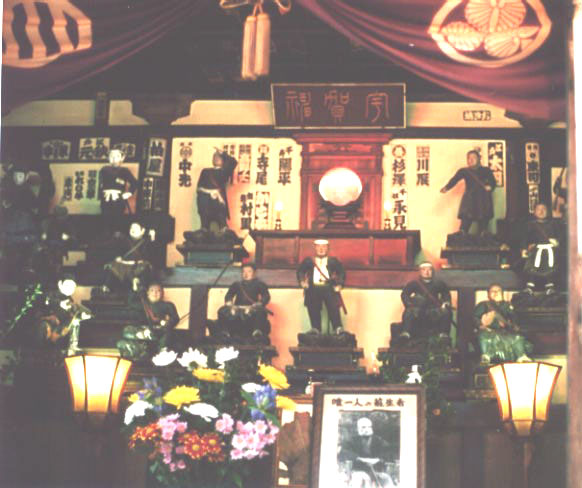
One day in 1868, nineteen boys committed ritual suicide on Iimoriyama, a hill on the edge of Wakamatsu City, the capital of their lord's domain. The boys were members of the Byakkotai (White Tiger Brigade), a corps of young samurai in the service of the Aizu daimyo. They were sixteen and seventeen years of age by Japanese count--meaning that in Western terms, some may have been as young as fourteen.
 |
A shrine to the Byakkotai at Iimoriyama. |
Engaged in a last-ditch effort to defend their domain, the boys intended to follow their lord to his death when they saw smoke in the distance and mistakenly identified it as a fire destroying Tsurugajō, the daimyo's castle. The war was lost and the castle was eventually destroyed, but the daimyo himself lived well into old age.
The Byakkotai suicide captured the imagination of the people of Aizu, and the nineteen boys--plus a twentieth who remained alive to tell their story--are celebrated as heroic exemplars of bushido, the samurai code that enjoined loyalty and absolute sacrifice for one's lord. When the local faithful wanted to rebuild Sazaedō, for example, they proposed enshrining portrait statues of the Byakkotai in the temple building. Currently, one of the main streets of Aizu-Wakamatsu City is named Byakko Avenue, and the boys' tragic story is told and retold at official occasions in the city.
Ironically, the Byakkotai were among the few wartime followers of bushido, a code that was actually formulated during the centuries of peace under the Edo regime. In the civil war period that preceded times of war, leaders of course had recommended absolute loyalty and self-sacrifice to their followers. The whole process of civil war, however, involved "inferiors" rebelling against their "superiors"--a phenomenon known as gekokujō--and warriors rose to the top primarily by pursuing their own advantage.
By the time peace came in the Edo period, daimyo had succeeded in curbing samurai independence, and most samurai became domain functionaries dependent on their lords for income and preferment, rather than the small landholders many had been before. Samurai were forbidden to change lords, and laws barred them (though not always successfully) from becoming farmers or merchants. The bushido code of loyalty and sacrifice--even on behalf of a cruel or foolish lord--was imposed on samurai who had little choice but to accept it.
Samurai saw little military action during the Edo period, except when they had to suppress peasant rebellions. On occasion, however, a samurai was forced to commit seppuku-- disembowelment with one's sword--in apology for offending his lord in some way. Because it was so painful, seppuku had become a ritual that restored a samurai's honor if he had lost it. It was also the way in which a samurai was supposed to follow his lord in death, a practice officially prohibited in the Edo period but honored as the ultimate in sacrificial loyalty.
Bushido was codified by the samurai intellectual Yamaga Sokō, a native of Aizu who had moved to Edo as a child. The code took principles of loyalty and obedience to superiors from Confucian ethics, and combined them with a Zen-based stoicism in the face of death. Yamaga also stressed the samurai's need for learning and his obligation to act in a moral way. By making the peacetime samurai into an exemplar of virtue, Yamaga justified the samurai's apparent lack of gainful employment:
The business of the samurai consists in reflecting on his own station in life, in discharging loyal service to his master if he has one, in deepening his fidelity in associations with friends, and, with due consideration of his own position, in devoting himself to duty above all. (From Shidō (The Way of the Samurai), translated in Tsunoda, De Bary, and Keene, Sources of Japanese Tradition, Vol. 1, p. 390)
Educated at the Nisshinkan, the Confucian school of the Aizu domain, the Byakkotai youths had learned well the principles of bushido. One can view their mass suicide as the pinnacle of samurai loyalty. One can also view it as a tragic example--similar in some ways to the Children's Crusade of medieval Europe--of how war wastes the lives of the young.